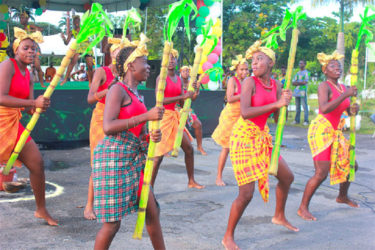African dance will no doubt be at the top of the agenda during this season of Emancipation celebrations. Especially today, more specifically tonight at the various libation ceremonies, and tomorrow, which is Emancipation Day across the Caribbean. Dance will be a vehicle for commemoration in a range of contexts – entertainment, social, religious, traditional and ritual. However, in the African diaspora, in the Caribbean and particularly in Guyana, the question of what is African dance is relevant and cannot be taken for granted.
 Because of the unmistakable impact of African slavery throughout the western world and on all the different cultural and ethnic communities across the Americas, there is a distinct African focus in the commemoration of Emancipation. Often, in the thinking of many, including African descendants themselves, it is too restricted and narrowly confined to the ‘African’ community. Yet, there is good reason for the African focus. It was the Africans whose liberation was accomplished on August 1, they were the ones for whom three centuries of a notorious life-changing international institution came to an end. On that date the African heritage claimed its proper place in the society despite the fact that the battle was not over on August 1. Liberation remains unfinished business, but the Emancipation commemoration reminds all of the importance and impact of the African presence in these regions of the world.
Because of the unmistakable impact of African slavery throughout the western world and on all the different cultural and ethnic communities across the Americas, there is a distinct African focus in the commemoration of Emancipation. Often, in the thinking of many, including African descendants themselves, it is too restricted and narrowly confined to the ‘African’ community. Yet, there is good reason for the African focus. It was the Africans whose liberation was accomplished on August 1, they were the ones for whom three centuries of a notorious life-changing international institution came to an end. On that date the African heritage claimed its proper place in the society despite the fact that the battle was not over on August 1. Liberation remains unfinished business, but the Emancipation commemoration reminds all of the importance and impact of the African presence in these regions of the world.
That is why things African are highlighted and there are attempts to resurrect traditions and assert flags of identity. There are customs of wearing African dress, an Emancipation festival in the National Park of Georgetown, various vigils, village fun days especially in some of the purchased villages, attempts to revive soirees, attempts to reconstruct libation ceremonies, attempts to provide relevant food items, and attempts to exhibit African performing arts.

The dance becomes a common form of expression at this time, and this is where ‘what is African dance?’ becomes a valid question. Dance has been and continues to be an extremely important and ubiquitous vehicle in African societies for innumerable purposes. These include recreation, work, rites of passage, mourning, the initiation of a public official (kings in the old days) and competition. Dance is quite appropriately said to be “deeply woven into the social fabric of Africa” (John Picton, Encyclopaedia Britannica). It is therefore not surprising that Guyana and the Caribbean turn to reputed forms of African dance to mark the anniversary of Emancipation.
The continent is not homogenous and is made up of several different cultures and societies, so we are not talking about a single form. But dance traditions in the various countries tend to revolve around similar forms, functions and patterns. Dance is entertainment, more so in more recent times, but it always tends to have a social context. Traditionally it is linked to social functions. Dance has a role in rituals; healing; rites of passage such as weddings, burials, puberty, births; political occasions such as coronations; competitions between villages or other groups. It is used for the instruction of both adults and children. It is also a means of social control where it influences morals and acceptable behaviour within a community.
Quite overwhelmingly, dance is religious. Dancers communicate with gods, and in ancestor worship, with spirits; spirit possession is common in religious dances. The wearing of masks is prevalent in dance and in many religious ones the mask represents a deity or a particular spirit. The tradition is that once a dancer wears such a mask he or she virtually becomes the god who is regarded as visiting while the identity of the dancer is deliberately kept secret. For instance, the Ibo and the Egungun of the Yoruba have traditions in which men who are members of a secret society whose identities are not revealed, dance wearing masks to represent gods who have come to visit. The practice in the Kalabari region is similar and it is this tradition that is most similar to the masquerade and jonkunnu dancers in the Caribbean.
There are several characteristics of style and custom which may identify dances as African, and these are exhibited in the choreography. African dances are normally gender sensitive. Men and women generally do not dance together; they play different roles and have moves assigned and associated to them separately. Although this mostly applies to older periods and to traditional forms, it remains very influential in modern dance in Africa.
While many traditions have changed, one relevant factor is that there are characteristics which may identify dance forms as African. These may relate to style, movement, divisions between the sexes, rhythms, formations and the many different types of coded costuming.
Among the changes in traditions are those found in recreation and entertainment, such as in the West African ‘high life,’ a rhythmic form of music for dancing in parties and clubs. This moved from its indigenous roots in the 1950s, changing gradually over the decades from contact with western dance and the use of popular modern and electronic musical instruments.
Where African dance is concerned in the Caribbean, it becomes more relevant to look into exactly what it is. Take for instance, choreographies which are composed with an African label. There is the ‘Congo Creole,’ which is in the repertoire of the National Dance Company of Guyana and is one of the best examples of African dance seen in the country. ‘Congo Creole’ is choreographed out of a knowledge of African dance and is in several ways reflective of it. In describing the performance text of this dance one is actually looking at details of African form in the dance.
The dancers’ foot movements are reminiscent of being earth-bound, where the use of the feet and contact with the ground are concerned. There are pelvic body movements—a known characteristic of the continent—and other postures from the erect regal stance to the bending over from the waist. The music, of course, is African so that the dance makes use of the rhythms given in the creation of the relevant moves.
The costuming is elaborate, symbolic and colourful and in itself reflects further elements of African dance traditions. It is coded to bring out both the gaiety of entertainment and the more solemn religious factor. Waist bands and head ties are used, which are themselves colour coded, since in the original customs and those that have survived in the Caribbean, colours represent different deities in the same way that drum rhythms do. ‘Congo Creole,’ then, as a choreography in modern dance, may be held up as a lesson in what can be called African dance.
Another example may be taken from a Guyanese tradition, the kwe kwe (queh-queh). The kwe kwe (also known in different parts of Guyana as kwe ke, kakalay and mayan) is a pre-wedding ritual indigenous to Guyana. It evolved in Guyana within the folk communities and was not imported from Africa like other dance traditions. Yet it is remarkable as a social institution that transcends dancing and the songs that make it up as a musical form. It is a culture and a way of life of a people which is used to teach moral behaviour and, in particular, chastity.
What is relevant about the kwe kwe is how it works as a dance form that strongly reflects African characteristics. First, the foot movements. It may be surprising to hear some sources say that the most common musical instrument used in African dance is the human voice (Encyclopaedia Britannica), as it is universally believed to be the drum. But in the original kwe kwe tradition that has survived in some villages, drums are not used. The rhythm to which the dancers move is created entirely by the pound of the feet on the ground. This is a particular African characteristic. Second, the formation. Kwe kwe dancers form a circle and move around its circumference in an anti-clockwise direction. This is common in many other African-derived folk traditions. Further, the dancers are also singers and they are led by a lead singer known as the “tutor” or as the “chantwelle” in Trinidadian and Eastern Caribbean customs. The lead singer stands apart from the circle and is also the spiritual leader of the ceremony. These are specific African characteristics.
Third, the ritual factor. The performance and audience are one. There is no division between dancers and spectators, which is an African phenomenon. One may add to those, the way this Guyanese cultural tradition functions as a means of social control to put down promiscuity and promote chastity. Moreover, it is a dance of fertility as it contains considerable sexuality in gesture and lyrics. There are also elements of rivalry and competition. All of these are characteristics of African dance.
In spite of the foregoing, Guyana is not the shining example of the preservation of African dance forms in the Caribbean. In fact, it lags far behind several of its neighbours in this regard.
The soirees, which are folk, street dances held at Emancipation time have faded completely into street fetes driven by dance hall and soca music. Most of what is called African dance is merely so described because it is accompanied by drums, which really is a misnomer.
Many of the choreographers in Guyana designing African dances are not as informed about it as the National Dance Company and the National School of Dance.
While there is African dance existing in folk form in Guyana, it is either not properly researched, or the research is incomplete. In addition, it tends to fade away when misunderstood, like the Kumfa (generally written as Cumfa). This folk religion is sometimes ridiculed, feared and often confused with obeah, which is itself grossly misunderstood. But Kumfa is not obeah, it is a different folk religion with dance at its centre. However, it has the African characteristic of spirit possession which is a source of fear in Guyana.
Nevertheless, this form of dance is prevalent around the Caribbean and has survived much better in such countries as Haiti, the Dominican Republic, Jamaica and Trinidad and Tobago. There are the Vodou of Haiti and the Kumina of Jamaica, both of which are folk religions with dance and spirit possession at their centre. But they are also often performed on stage for the benefit of an audience. Another is the Shango of Trinidad, which is the same, but not known to be put on stage in the same way.
Where modern choreography is concerned, there are powerful African dances created in Jamaica by Rex Nettleford of the National Dance Theatre Company, such as ‘Kumina,’ ‘Myal’ and ‘Pocomania,’ which demonstrate the characteristics of the form, much as ‘Congo Creole’ does. But more than in Jamaica, Haitian dance is famous for incorporating these elements which have survived with force in that country.
Research into the true forms of African dance in Guyana badly needs to be done before all traces disappear. A study of the very rich legacy of these dances in Jamaica, Haiti and Trinidad and Tobago is exceedingly rewarding.









